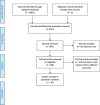Risky behaviours and their correlates among adolescents living with HIV in sub-Saharan Africa: a systematic review
- PMID: 30355344
- PMCID: PMC6201550
- DOI: 10.1186/s12978-018-0614-4
Risky behaviours and their correlates among adolescents living with HIV in sub-Saharan Africa: a systematic review
Abstract
Background: Adolescents living with HIV (ALWHIV) in sub-Saharan Africa encounter multiple health problems that are often unrecognised by the public and the healthcare workforce. The aim of this systematic review was to identify risky health behaviours and their associated factors among ALWHIV in sub-Saharan Africa.
Methods: We systematically searched for articles in Medline, SCOPUS, Directory of Open Access Journals, Science Direct, ProQuest, Psych-info, Web of science, WHO Global Index Medicus library, Cochrane, and Google Scholar. Studies were included in this review if: they were original studies; participants were aged from 10 to 19 years; participants were ALWHIV or they had data from different key informants focusing on ALWHIV within the age group; they had health behaviours as an outcome; they were conducted in sub-Saharan Africa and were published before December 2016. Data were extracted and the quality of the studies was appraised using the Mixed Method Appraisal Tool (MMAT).
Results: Thirty-six studies met the eligibility criteria. Nineteen studies scored 100% (indicating high quality), sixteen studies scored 75% (indicating moderate quality) and one study scored 50% (indicating low quality) on the MMAT scale. Adherence to antiretroviral therapy among ALWHIV was suboptimal and was negatively affected by forgetfulness, opportunistic infection, long distance to clinics, and fear of unplanned disclosure. Many adolescents were sexually active, but the majority did not disclose their HIV status to sexual partners, despite knowing their diagnosis (range 76-100% across available studies) and some did not use protection (condoms) to prevent transmission of HIV and other sexually transmitted diseases (range 35-55%). Disclosure to and from adolescents was low across the studies and was associated with fear of disclosure aftermaths including stigma and discrimination (range 40-57%).
Conclusion: A considerable proportion of ALWHIV in sub-Saharan Africa engage in multiple risky health behaviours, which have a substantial negative impact on their wellbeing and cause significant risk and burden to their families, sexual partners and societies.
Keywords: ART adherence; Adolescents; Correlates; HIV disclosure; Health behaviour; Living with HIV and AIDS; Risky behaviour; Sub-Saharan Africa.
Conflict of interest statement
Ethics approval and consent to participate
Not applicable.
Consent for publication
Not applicable.
Competing interests
The authors declare that they have no competing interests.
Publisher’s Note
Springer Nature remains neutral with regard to jurisdictional claims in published maps and institutional affiliations.
References
-
- The United Nations Children's Fund. For Every Child, End AIDS. In: Seventh stocktaking report. New York: The United Nations Children's Fund. p. 2016. https://data.unicef.org/wp-content/uploads/2016/12/HIV-and-AIDS-2016-Sev.... Accessed 14 Apr 2017.
-
- The United Nations Children's Fund. All in to #EndAdolescentAIDS: The United Nations Children's Fund; 2013. https://www.unicef.org/media/files/ALL_IN_brochure_En_v02(1).pdf. Accessed 14 Apr 2017.
-
- World Health Organisation. Adolescent health. In: sixty-eighth world health assembly. World Health Organisation; 2015. http://apps.who.int/gb/ebwha/pdf_files/WHA68/A68_15-en.pdf. Accessed 20 Apr 2017.
-
- Otokpa AO, Lawoyin TO, Asuzu MC. Knowledge on HIV/AIDS and sexual risk behaviour among pregnant women in Gwagwalada area Council of Abuja, Nigeria. World J Prev Med. 2015;3:73–83.
Publication types
MeSH terms
LinkOut - more resources
Full Text Sources
Medical
Molecular Biology Databases
Miscellaneous


